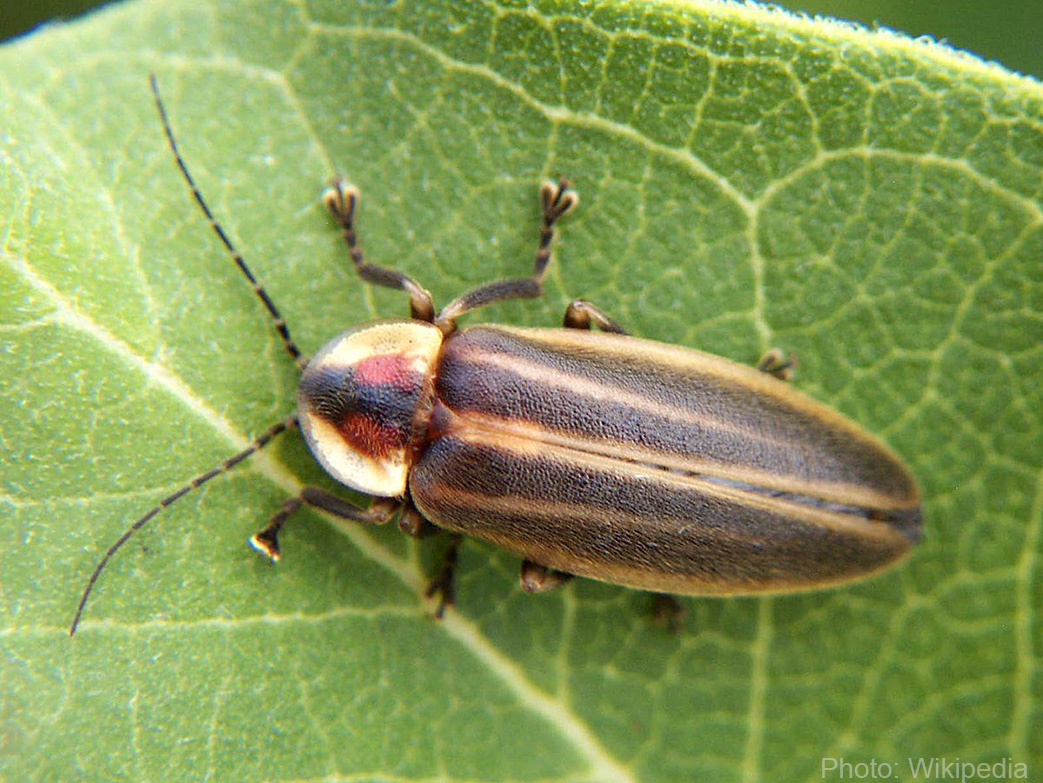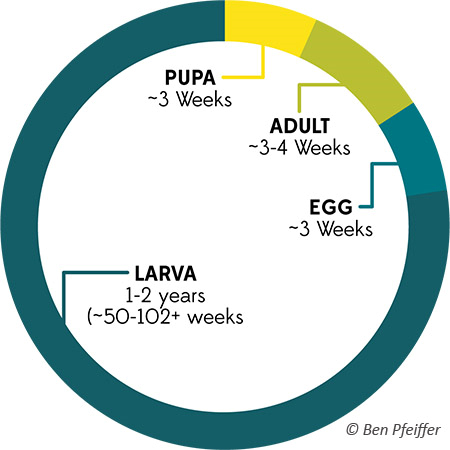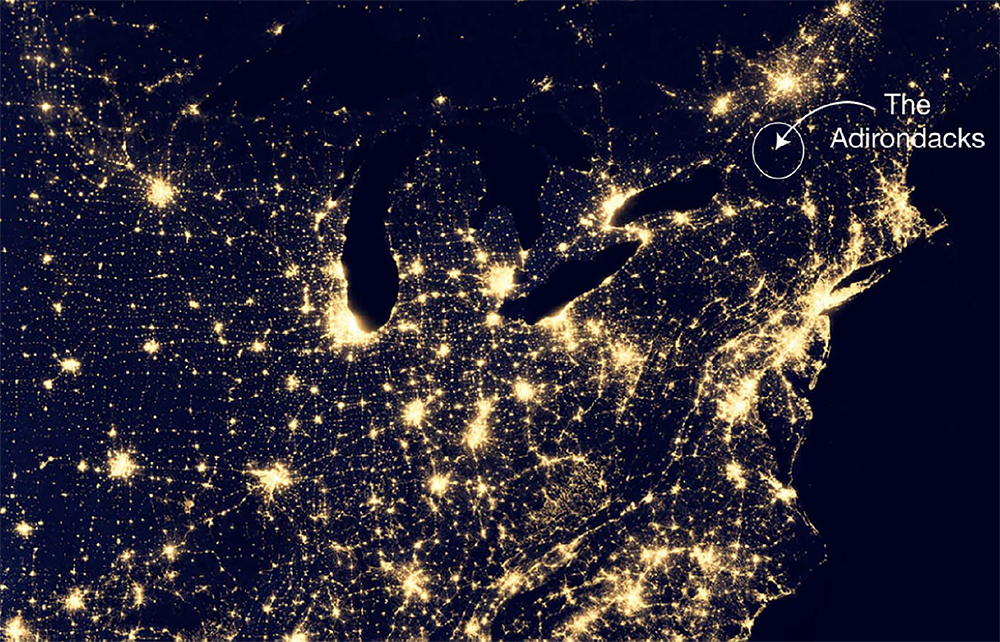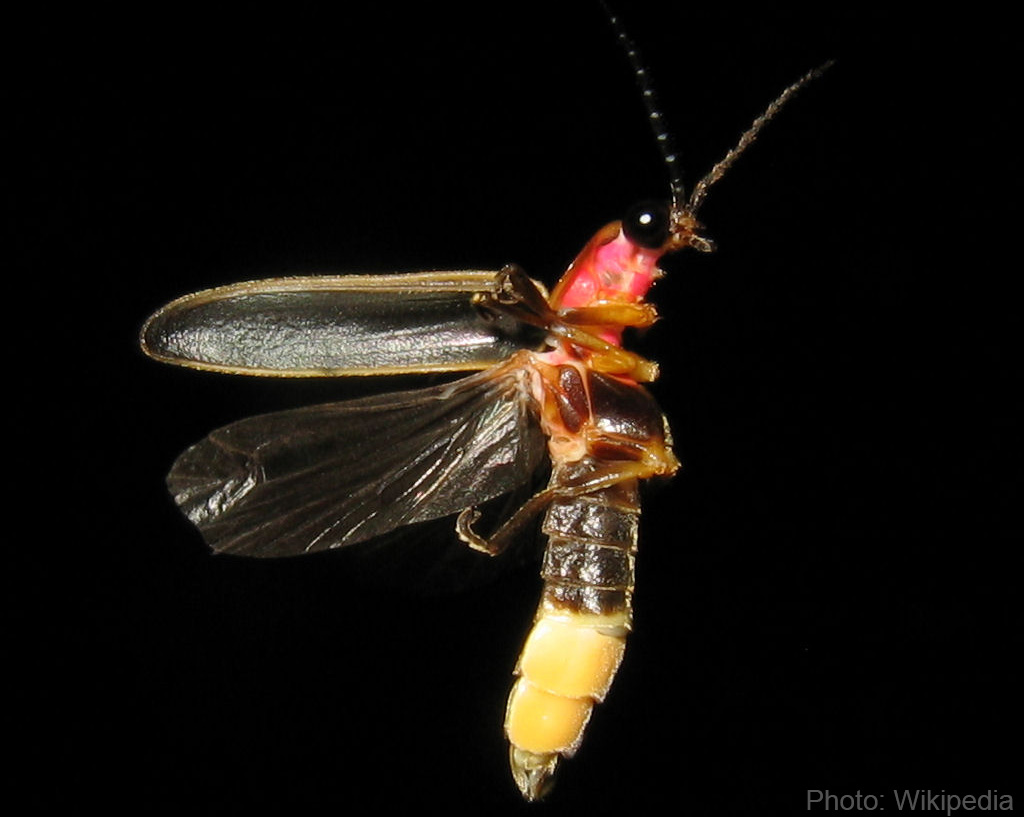
8 Interesting Things About Fireflies
By: Lisa M. Genier - Adirondack Council Program Analyst
Monday, August 31, 2020
One of the things I love about sitting outside on a warm summer Adirondack night is seeing the flashes of fireflies (Lampyridae). As I was watching these little flashy creatures perform their spectacular light displays, I realized how little I know about them. Why do they flash? What are they trying to convey? This led me to find that there’s more to fireflies than meets the eye.
1. Fireflies are Actually Beetles
Although we call them fireflies, these creatures are actually beetles. As other beetles, like ladybugs, fireflies have a pair of hardened wing cases, called elytra in which the wings fold underneath. The elytra open allowing the wings to be free for flight.

2. Fireflies are Found on Almost Every Continent
There are more than 2,000 species of fireflies worldwide and they are found on every continent except Antarctica. Many species will share one habitat, so you are probably seeing a few different types of fireflies when you are watching them in your yard.
Fireflies need a moist environment to survive and are found around wet or damp areas that retain moisture. They thrive in forests, fields, and marshes near lakes, rivers, and streams. Some species of firefly larvae live in trees while others are aquatic, even having gills! With abundant classified wetlands and protected forests and waters, the Adirondacks provide a welcoming habitat for fireflies.
3. Most of Their Life is Spent as Larvae
Female fireflies lay eggs in the ground and the larvae will spend up to two years in this stage until they change or metamorphose into adult fireflies. They, like adults fireflies, emit a glow, but as a defense mechanism. The larvae are grub-like and vicious predators. They feed on worms, slugs, and snails by injecting them with a numbing fluid. Adult fireflies only live a few weeks and some feed on nectar or pollen, but most don’t eat at all. They just mate, lay eggs, and then die. So, this means the fireflies that we are seeing in our backyards this summer are from eggs that were laid in 2018. And they will be the parents of fireflies that we won’t see until 2022.
 4. Fireflies Use Flashes as Mating Signals
4. Fireflies Use Flashes as Mating Signals
The fireflies you see flashing are males looking for females. Males flash a specific pattern when they fly and hope a female will reply. If a female firefly likes what she sees, she will respond with a flash of her own. The fireflies will have this “conversation” until the male locates the female and they mate. Each species of firefly has its own pattern. This allows the fireflies to find the right mates of the same species. Some fireflies found in Southeast Asia congregate in trees and synchronize their flashes and blink in unison to send their mating signals.
To produce these flashes of light, fireflies have light organs located under their abdomens. They take in oxygen and combine it inside special cells with a substance called luciferin to produce light with almost no heat.
However, there are some firefly species that don’t use light as a mating signal at all. Instead, they use smells, or pheromones, to communicate.
5. Some Fireflies are “Femme Fatales”
The females of one group of North American fireflies, called Photuris, are known as “femme fatales” because they lure unsuspecting males to their deaths. Unlike many species, these fireflies eat as adults. By mimicking the flash patterns of other firefly species, the female lures males in and will eat them as her dinner. Preying on males of other firefly species allow the Photuris females to acquire their toxins, called lucibufagins. The females then will put this into their eggs as a chemical defense.
6. There are Winter Fireflies
You may be surprised to know that there is one North American firefly species that is active in the winter (Ellychnia corrusca). Although their eggs, larvae, and pupae do emit light, the adults do not. In September, these fireflies emerge to search for overwintering sites and huddle in tree bark through the winter. They find their mates in April and May with pheromone signals, lay their eggs, and then are gone before the summer fireflies arrive.
7. Certain Fireflies are Huge
Females of the Lamprigera firefly found in Asia can grow to be the size of your palm. These females are larger than the males and lack wings.
8. Fireflies Do Not Make Tasty Prey
When attacked, fireflies shed drops of blood in a process known as “reflex bleeding.” The blood contains chemicals that taste bitter and can be poisonous to some animals. Because of this, many animals have learned not to eat fireflies.
The Bad News: Fireflies are Disappearing
Unfortunately, firefly populations all over the world are dwindling. Although no one knows why for sure, but habitat loss, pesticide use, climate change, and light pollution seem to be the reasons.
Light pollution is believed to interrupt firefly flash patterns. In fact, scientists have observed that synchronous fireflies will get out of synch for a few minutes after a car’s headlights pass. Light from houses, cars, stores, and streetlights may also make it difficult for fireflies to signal each other during mating. Unfortunately, this means fewer firefly larvae will be born next season.
The Adirondack Park, with its outsized dark skies, is a great place for fireflies because of its limited light pollution.

The Good News: You Can Help Fireflies
There are a few things that you could do to help save fireflies. And every little bit counts! Allow some wildness on your property. Leave some low-hanging trees, forest litter, or long grasses. These are all welcoming to fireflies. Moist habitat is crucial for firefly populations, so if possible, have a water feature on your property. Also, reduce the amount of light in your yard at night and don’t use chemical fertilizers and pesticides. By doing just a little, you will help keep fireflies brightening up our summer nights for years to come.
 Lisa M. Genier joined the Council in 1992 working as its Legislative Associate in the Albany office. During her tenure, she played a role in the creation of the Environmental Protection Fund, which has been used to fund land purchases and environmental programs in the Adirondack Park and around the state. She was also a member of the negotiating teams that worked on re-licensing agreements for several hydroelectric facilities in the Park, which preserved thousands of acres of land, expanded recreational opportunities, and protected other natural resources. Lisa now works part-time as Program Analyst writing action alerts, interacting with members, managing the Council’s website, and serving in a consultative role on legislative and other issues
Lisa M. Genier joined the Council in 1992 working as its Legislative Associate in the Albany office. During her tenure, she played a role in the creation of the Environmental Protection Fund, which has been used to fund land purchases and environmental programs in the Adirondack Park and around the state. She was also a member of the negotiating teams that worked on re-licensing agreements for several hydroelectric facilities in the Park, which preserved thousands of acres of land, expanded recreational opportunities, and protected other natural resources. Lisa now works part-time as Program Analyst writing action alerts, interacting with members, managing the Council’s website, and serving in a consultative role on legislative and other issues





